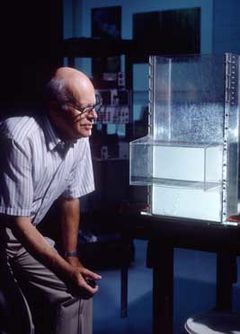Stewart Turner facts for kids
Quick facts for kids
John Stewart Turner
|
|
|---|---|

Stewart Turner in his laboratory.
|
|
| Born | 11 January 1930 |
| Died | 3 July 2022 (aged 92) |
| Scientific career | |
| Institutions | Cambridge University, University of Manchester, Woods Hole Oceanographic Institute, C.S.I.R.O., Australian National University. |
| Notable students | Paul Linden, Trevor McDougall, Peter Baines, Peter Manins, Ross Griffiths. |
John Stewart Turner (born January 11, 1930, died July 3, 2022) was an Australian geophysicist. A geophysicist is a scientist who studies the Earth using physics, like how heat moves inside the Earth or how oceans behave. He was known for his important work on how fluids (like water or air) move and mix, especially in oceans and the atmosphere.
Contents
Early Life and Studies
Stewart Turner went to North Sydney Boys High School and then Sydney University. After that, he joined a group at CSIRO (a big science organization in Australia) that studied clouds. He even won a special scholarship to study at Cambridge University in England.
Studying Clouds at Cambridge
John finished his PhD (a high-level university degree) at Cambridge University in 1956. His research was about how clouds form and move. This work was very important and even helped explain how clouds formed from nuclear explosions.
At the time, there were nuclear tests happening in Australia. Scientists needed to understand how high the clouds from these tests would go. John's experiments and ideas helped them get much more accurate predictions.
He also worked with another scientist, Bruce Morton, on how liquids mix when they have different densities (like oil and water). This research became a very famous result in fluid dynamics.
Working in Manchester
From 1958 to 1959, John worked at the University of Manchester. He helped with a project to understand how methane gas mixes in coal mines. Methane gas can cause dangerous explosions in mines.
John used experiments with salt water and fresh water to see how layers of gas would mix. He found that, surprisingly, it was better to ventilate mines downhill to get rid of the gas quickly. This new idea helped make mines safer in Britain very quickly.
Back to Australia with CSIRO
Later, John returned to Australia and rejoined the Cloud Physics group in Sydney. During this time, he used an early computer called SILLIAC for some of his work. This was one of the few times he worked directly with computers. While at CSIRO, he also got a chance to work at the Woods Hole Oceanographic Institute in the USA.
Exploring Oceans at Woods Hole
In 1962, John moved to the Woods Hole Oceanographic Institution. Here, he focused on something called "double diffusion." This is a way that different layers of water in the ocean can mix, even if they have different temperatures or saltiness.
He even got to go deep into the ocean in a special submarine called DSV Alvin! John often returned to Woods Hole to work on problems and teach at their summer school.
Return to Cambridge University
In 1966, John went back to Cambridge University. He worked in the Department of Applied Mathematics and Theoretical Physics. It was unusual for a math department to have a lab, but John's lab became very well-known around the world. He continued to study how different layers of liquids mix, like in "salt fingers."
Writing a Famous Book
In 1973, John published a very important book called "Buoyancy Effects in Fluids." This book brought together many new ideas about how fluids move when they have different densities. It included his own major work on things like plumes (like smoke rising) and how layers mix in the ocean. His research often used lab experiments to understand how things work in the real world.
Leading a New Group in Australia
In 1975, John returned to Australia again. He became the first Professor of Geophysical Fluid Dynamics at the Australian National University in Canberra. He built a new research group there that studied how fluids move on Earth. Their projects included looking at how crystals form and how heat moves under the seafloor.
Later Years and Impact
John retired in 1996 but continued to be active at the Australian National University for many years. His basic research on how fluids with different layers behave has had a big impact on how we understand oceans, lakes, and even how engineers design things. You can even find videos of his experiments online!
In 2010, he was recognized as the first Fellow of the Australian Fluid Mechanics Society. This showed how important he was as a scientist in Australia. Many of his students went on to become important scientists themselves.
Death
John Stewart Turner passed away on July 3, 2022, at the age of 92.
Awards and Honors
- 1958 - Fellow, Royal Meteorological Society
- 1969 - Fellow, Institute of Physics
- 1979 - Australian Academy of Science
- 1980 - Fellow, Australian Institute of Physics
- 1982 - Fellow, Royal Society, London
- 1990 - Matthew Flinders Medal and Lecture
- 2001 - Centenary Medal for service to Australian society and earth sciences
- 2010 - Inaugural Fellow, Australian Fluid Mechanics Society
Images for kids




